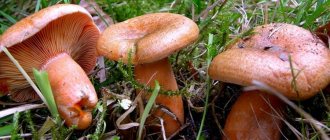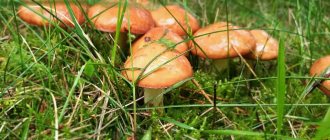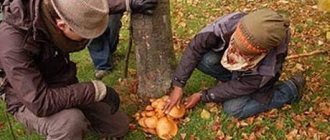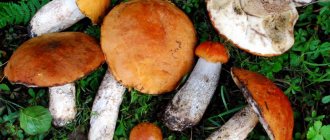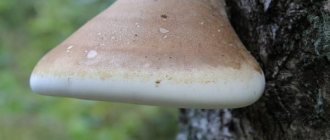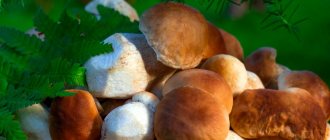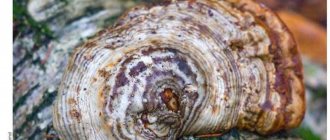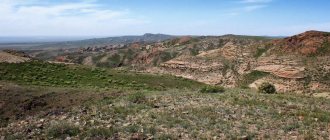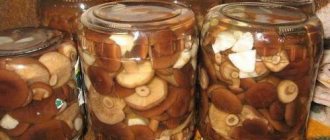Russula is one of the most common types of mushrooms in forests. With their bright hats, they seem to beckon lovers of quiet hunting. There are about 275 varieties of them; more than 60 species grow in the European part. Mushrooms get their name because some of them can be eaten raw. However, is it worth doing? Find out everything about the types of these mushrooms (edible and poisonous), how to correctly identify them and what to cook from them.
Botanical description
Russulas are cap mushrooms that grow on an even stalk, without tubers or rings. In young representatives, the apex is hemispherical, which straightens with age and becomes flat, reaching 10 centimeters in diameter. Russulas are widespread everywhere: in rare birch forests, in pine and deciduous forests, on the roadside, on a mossy bank, at the edge. The best period for collecting forest beauty is August-September.
Description:
- Hat. Initially it has a bell-shaped, hemispherical, spherical configuration, later it becomes funnel-shaped, flat or prostrate, less often - convex. The edge of the cap is striped or ribbed, curled or straight. The skin is of various colors, shiny or matte, dry, less often wet, adherent, easily separated from the pulp, sometimes cracking.
- Records. Descending or free, adherent, notched, equal or unequal in length, frequent, sometimes sparse, forked-branched. The color of the plates is white, yellowish, the edges are blunt, pointed, depending on the type.
- Leg. White or colored, cylindrical, smooth, rarely pointed, thickened at the base, dense or hollow inside.
- Pulp. White, does not change color with age and when cut, spongy, fragile, dense in the stem, with a soft, subtle taste. Burning and pungent notes indicate that the mushroom is poisonous and unsuitable for consumption.
- Spore powder. Color varies from white to dark yellow.
Russulas are edible in 90% of cases, some have a bitter taste, which, as a rule, disappears after heat treatment and soaking.
It is not recommended to eat mushrooms raw, as they irritate the mucous membranes of the digestive system and can lead to vomiting, poisoning and intoxication of the body.
Collection rules
The best time to go for russula is in August and early September. They will be fairly mature, but not overgrown. You should not pick mushrooms on the roadsides; you need to go deeper into the forest, where the air is cleaner.
Advice!
You need to go foraging for mushrooms early in the morning, having with you a small knife and a wicker basket, as well as a stick for tedding the grass. Most russula are very fragile, so you need to either choose stronger varieties (discussed above) or collect them as carefully as possible, gently untangling the mushroom from the grass, carefully freeing it from the branches and transporting it without shaking.
Popular edible species
- Russula food. The mushroom cap is fleshy, uneven in color, finely mesh-wrinkled, reddish, white-pink. In the middle it is brownish and ocher. It reaches 5–10 centimeters in diameter. The edges of the cap are slightly ribbed or smooth, the plates are frequent, of equal length, yellowish-white, branched at the stem. Fruits in July-October. Similarly, the mushroom can be confused with herring russula, the latter, in turn, has a pronounced fishy smell.
In folk medicine it is used as a diuretic, in cooking for pickling, salting, and making soups.
- Russulas are greenish (scaly). This is the most delicious type of mushroom among all existing ones. All kinds of preparations are made from them, subjected to all types of culinary processing, with the exception of drying. The cap of the scaly russula is green, sometimes with a bluish tint, fleshy, with tightly adherent skin. Its surface is thick, dry, rough, warty, cracking with age, reaching 5–12 centimeters in diameter. The plates are white, sometimes with a yellowish tint. The pulp is dense, fragile, and emits a pleasant mushroom smell. The leg is white, furrowed, and becomes brown with age. When scrapped, the russula changes color and becomes rusty. Fruiting period – July – October.
According to the conclusion of Chinese biochemists, R. Virescens extract has a beneficial effect on the regulation of blood lipids. With regular consumption of the mushroom for 30 days, a decrease in triglycerides and total cholesterol is observed. In addition, the level of serum and liver malondialdehydes decreases, and the content of the enzyme superoxide dismutase increases.
The main beneficial property of russula of this type is the ability to suppress Ehrlich carcinoma and saracoma-180 by 90%.
- Russula turns brown. The mushroom cap is dark red, brown-ocher, yellowish, olive, burgundy with a purple-brown or black center, strongly convex. Reaches 5 – 15 centimeters in diameter. Sometimes with the purple edge folded inward. The plates are soft, branched at the stem, cream, ocher or brown in color, and turn brown when pressed. When scrapped, the flesh is white, darkens over time, the leg has a herring smell, which intensifies towards the base, the cap has a crab or nutty taste. The leg is white, rarely with rusty spots, it can be pink or red.
Russula brownish is characterized by a rich amino acid and protein composition. An extract from fresh fruiting bodies inhibits the growth of pyrimethamine-resistant malaria parasites, Plasmodium falciparum.
- Russula is blue-yellow. A distinctive feature is the variety of colors, which can be multi-colored or blurry. The color of the cap varies from purple, blue to dark green, red-brown, and its diameter reaches 15 centimeters. The surface of the mushroom is sticky, shiny, with a ribbed edge. The flesh and stem are white, the plates are flexible and completely unbreakable. Fruits from June to October.
Polysaccharides from the fruiting bodies of the fungus have antitumor and antioxidant activity.
- Russula olive (herring). The cap is convex, prostrate, 5–12 centimeters in diameter, glabrous, slightly mucous, depressed in the center, with a ribbed edge. The flesh is white, turning brown with age. The skin is easily separated from the cap. Olive russula emits a characteristic herring smell, which is especially noticeable in aging mushrooms at the base of the stem. The plates are frequent, adherent to the stem, white. With age they become creamy and turn brown when pressed. The thickness of the leg is 2 centimeters, height is up to 10 centimeters, the surface is smooth, dirty pinkish-yellow or white.
Fruits in July-August.
Used for salting, pickling, making soups, frying.
Russula fading
| Group: | Lamellar |
| Records: | White |
| Color: | Crimson |
| Info: | Turns red when cut |
| Department: | Basidiomycota (Basidiomycetes) |
| Sub-department: | Agaricomycotina (Agaricomycetes) |
| Class: | Agaricomycetes (Agaricomycetes) |
| Subclass: | Incertae sedis (uncertain position) |
| Order: | Russulales |
| Family: | Russulaceae (Russulaceae) |
| Genus: | Russula (Russula) |
| View: | Russula exalbicans (fading russula) |
Description
The beautiful russula is characterized by a brightly colored cap, which “fades” over time, hence the name of the species.
hat
The caps of fading russula are usually small (up to 10 cm in diameter), but extremely large overripe specimens are found. The color is usually close to crimson, being darker at the edges. Enlightenment may be observed in the center. Small russulas have spherical, gradually opening caps. The surface of the cap is dry and smooth. As the mushroom matures and its size increases, the color of the cap fades. The skin is difficult to separate from the cap.
Leg
The leg of the beautiful russula is relatively thick and low (about 3 cm in thickness and 6 cm in length). It is cylindrical in shape with a widening downwards. Its color is predominantly white with a pinkish tint in the upper third. Yellow spots may appear in the lower third.
Pulp
In young specimens the flesh is white, while in older specimens it is greyish; when cut it turns red, then turns grey. The consistency is dense and hard, especially at the legs, so many people prefer to eat only the caps. The raw mushroom tastes bitter, but when cooked it is sweet.
Distribution and collection
The beautiful russula is distributed almost all over the world, but prefers temperate latitudes. Symbiotic coexistence is usually observed in russula fading trees with deciduous trees. But this species can also grow in coniferous forests.
Similar species
Russula fading has a rather characteristic appearance so as not to confuse it with other mushrooms. The only mushroom that is a little similar to it is Russula stinging or emetic.
The latter is distinguished by whiter plates (not darkening in mature mushrooms) and pulp that does not turn gray when cut. This mushroom has a very bitter taste and is therefore considered inedible.
Its use can cause stomach problems, as its name reflects. However, according to some sources, vomiting russula becomes edible if it is thoroughly boiled.
Edibility
Beautiful russula has, according to many consumers, very mediocre taste. The stems of these mushrooms are rarely eaten due to their toughness. We can say that russula is a mushroom for everyone; it is suitable for those who prefer a strong consistency of food. After boiling, the russula is fried with potatoes, salted and pickled.
Interesting facts
Russula mushrooms, including the species fading russula, are characterized by a number of interesting properties:
- Russulin, contained in russula, promotes the curdling of milk, so the components of russula can be used in cheese making.
- Lecithin, which is part of this mushroom, lowers the content of harmful cholesterol in the blood.
- Regular consumption of russula cleanses the gastrointestinal tract.
- Russula got its name not because it can be eaten raw. Quite the opposite: like any conditionally edible mushroom, it requires preliminary digestion.
And the name comes from the fact that pickles from these mushrooms are prepared faster than from others.
Not all mushroom pickers collect russula. Many people neglect them, since there are boletus mushrooms, fly mushrooms and other, more “valuable” mushrooms. However, fried or salted russula are also quite edible and tasty.
Healing properties and contraindications
Russulas are low in calories (100 grams of fresh product contains 19 calories), since they consist of 90% water and have a rich vitamin and mineral composition.
The benefits of forest gifts for the human body cannot be overestimated. Interestingly, in ancient times, mushrooms were used by folk healers to treat various ailments: frostbite, boils, headaches, psycho-emotional disorders.
The effect of russula on the human body:
- Supplied with vitamins, minerals, protein. Interestingly, to satisfy the body in proteins, it is enough to eat 150 - 200 grams of dried mushrooms per day. This property looks especially attractive to vegetarians and raw foodists who suffer from a lack of protein in their diet due to the exclusion of meat products from the menu.
- Strengthen the immune system and prevent cancer due to selenium content.
- They clean blood vessels, prevent the formation of cholesterol plaques, blood thickening, and the formation of blood clots, which cause the development of cardiovascular pathologies.
- They normalize metabolism, remove excess fluid from the body, and promote weight loss.
- Prevent emotional disorders, mental exhaustion, calm the nervous system.
- Improves the condition of teeth, nails, hair, skin, bones.
- Cleanses the stomach and intestines (adsorb harmful substances from the body).
Interestingly, mushroom juice is used externally in the fight against corns (keratinized skin on the feet). The safe daily dose of russula for a healthy adult is 150 grams. Be extremely careful when collecting forest products so as not to pick poisonous specimens.
Russula, like other types of mushrooms, belong to the category of difficult-to-digest foods. Despite the healing properties of the product, they are not recommended for use by people with acute inflammatory processes in the digestive system, impaired liver and heart function, with individual intolerance, children under 7 years of age, pregnant and lactating women.
First aid for mushroom poisoning
Although, as we have already written, russula do not pose a strong danger to human health, nevertheless, even with a mild degree of poisoning, someone who has eaten a toxic mushroom will require immediate help. In the case of russula, mouth rinsing, possibly inducing vomiting and gastric lavage will be required. In case of serious poisoning with poisonous mushrooms, damage to the gastrointestinal tract, cardiovascular system, central nervous system, liver and kidneys may occur.
It is important to provide assistance at the first symptoms of poisoning. Since, for example, treatment of lesions caused by toadstool, carried out on the second day, will already be in vain
Various poisonous mushrooms cause specific consequences when consumed internally, but what they all have in common is diarrhea, vomiting, and abdominal pain. The first signs of poisoning may appear at different times, depending on the mushroom eaten. So, for example, poisoning with toadstool will manifest itself within 8-18 hours, with lines - after 6-10 hours, with fly agarics - after 30 minutes or 2-6 hours, with false mushrooms - after 1-6 hours. You can remove poison from the body by vomiting. It is caused by drinking a glass of warm water with 1 spoon of table salt or 1 teaspoon of mustard. You can also induce vomiting by drinking a large amount of cool water, and then pressing two fingers on the root of the tongue.
Gastric lavage is mandatory. After the procedure, a person needs to consume activated carbon (1-2 tablets per 1 kg of weight). As you can see, there are many varieties of russula.
Unfortunately, it is not always easy to distinguish between edible and inedible russula. Sometimes even such characteristics as color, smell and taste cannot help with this. Remember: if you have the slightest doubt about whether the mushroom in front of you is good or poisonous, it is better to get rid of it.
When to collect?
Russula grows on the edges, clearings, and in all forests. The first young mushrooms appear in June, and the most productive time is in August. The most delicious russulas have yellow and green caps. Do not collect overgrown gifts of nature, they accumulate harmful foreign substances from the environment. Fresh, young mushrooms that have not been bitten by insects are suitable for food. Throw away wormy specimens immediately.
In order to return to a well-known place next time and collect a rich harvest of mushrooms, you should spare the mycelium: russula, like any gifts of nature, cannot be pulled out of the ground, they must be carefully cut off at the base with a knife.
Safety regulations:
- Don't pick a mushroom without identifying it. Collect only those specimens that you are sure of, otherwise you can cut off an inedible poisonous product that can cause intoxication of the body and even lead to death.
- All russula on the inside have white plates, white legs, without scales, films, or rings. Cut mushrooms practically do not change color. They remain white (rarely - barely turn yellow).
- If it rains heavily in the summer, avoid picking mushrooms, as they have become saturated with water, lost their taste, and released toxic substances.
- After harvesting, the mushrooms are re-sorted to identify “random” unsuitable specimens, then placed in a cool salty solution for an hour or three to eliminate insects and a bitter taste.
- Before eating russula, they are subjected to reliable heat treatment! Do not consume the product raw under any circumstances!
Mushrooms are picked in the morning before the sun heats them up. This way they will last longer. The cut specimens are immediately cleaned of debris, adhering needles, grass, soil and leaves, and placed in a basket with the cap down.
Mushroom picker equipment:
- stick for searching for mushrooms;
- electronic GPS navigator;
- mushroom basket;
- disinfectant and patch;
- telephone (to call emergency services);
- basket and knife for mushrooms;
- water and sandwiches.
Remember, poisonous mushrooms are often disguised as edible ones, so before you go into the forest, refresh the information on how to distinguish a good specimen from a toadstool. Don't put your health at mortal risk.
Mushroom is a treacherous product, follow safety rules!
Edible russula mushrooms: benefits and harms, what can be confused with?
Before talking about the benefits and harms of these mushrooms, it must be said that there are 2 types of russula, which can easily be confused with a really dangerous mushroom - toadstool.
- So, due to inexperience, green and greenish russula can be confused with toadstool, the consumption of which can result in the death of a person.
- Remember, there are no films, wrappers, etc. on the stem of the russula. The pale toadstool at the bottom of the stem has a kind of wrapper.
- On top of the toadstool’s leg you can also most often see a “skirt” made of film, on the russula the leg is “clean”, without films, etc.
- In russula, the leg is straight and even, without thickening; in a poisonous mushroom, the leg is thinner towards the top.
- Also pay attention to whether worms, bugs, etc. “love” the mushroom. As you understand, none of the representatives of the animal world will eat a poisonous mushroom. Therefore, if the mushroom is untouched and very beautiful, think about whether it is edible.
Russula is both useful and harmful.
Regarding the benefits of russula, the following must be said:
- These mushrooms, like many others, are a source of vitamins and microelements. For example, russula contains B vitamins in sufficient quantities.
- These mushrooms also contain fatty acids.
- Moreover, it is in the composition of russula that there is an enzyme called russulin, which promotes milk coagulation. This substance is extremely necessary in cheese making.
As for the possible harm from these mushrooms, we can say the following:
- The greatest harm can come not from russula, but from poisonous mushrooms, with which they can easily be confused. In this case, even fatal consequences are possible.
- Also, some types of russula can provoke mild poisoning and, accordingly, vomiting, nausea, etc.
- In large quantities, these mushrooms put quite a serious strain on the stomach and heart, so you need to eat them little by little.
Selection and storage
If you are not a mushroom picker, you can buy russula at the market from people who know a lot about them. The most important thing is to choose the right product. Examine the mushroom carefully. Real russula has a dense or hollow stem, smooth, white. The pulp is extremely fragile and may darken when cut (extremely rarely). There are no membranes. Cap of various colors with white or yellow plates. But under no circumstances can they be brown, black or red. If there is a crimson or purple spot on the cap, most likely it is a false inedible russula.
When choosing, give preference to dense mushrooms, avoid old, dried out specimens. Russulas that are blue-green or yellow are considered to be the highest quality and tastiest.
After harvesting, the crop retains its nutritional properties for the next 24 to 48 hours. It is believed that the mushroom is a perishable product that should be cooked immediately. If you plan to prepare the dish the next day, then dry russula is placed in the refrigerator.
Dried mushrooms can be stored for up to 1.5 years. And salted and pickled ones for no more than 1 year. Interestingly, after drying, forest bread retains beneficial amino acids and dietary fiber; only the protein, which makes up 40% of the original amount, is lost.
Features of representatives of the Russula family
Characteristics of russula and its distinctive features:
- curled or flat cap;
- wavy or slightly convex edges;
- smooth skin;
- the plates are spotted, with purple veins or amber drops;
- the flesh is white, sometimes taking on a slight tint of the color of the cap (photo 2).
There are many russulas in every forest. Many mushroom pickers believe that among the representatives of this family there are none that can cause serious poisoning. But this is not true at all. It is always important to distinguish between edible and poisonous species. After all, even one dangerous mushroom in a frying pan can harm your health. Therefore, you need to know what russula mushrooms look like, which should not be touched.
There are many russulas in every forest
Chemical composition
Russula is a dietary product rich in beneficial minerals, vitamins, and elements.
Mushrooms take a long time to digest in the body, creating a feeling of fullness, therefore they are recommended for consumption by people (in boiled form) who have embarked on the path of fighting excess weight. Table No. 1 “Nutritional value of russula”
| Components | Contents per 100 grams of product |
| Calorie content | 19 calories |
| Water | 90 grams |
| Alimentary fiber | 5.5 grams |
| Squirrels | 1.7 grams |
| Carbohydrates | 1.5 grams |
| Mono- and disaccharides | 1.5 grams |
| Ash | 0.6 grams |
| Omega-6 | 0.18 grams |
| Omega-3 | 0.175 grams |
| Saturated fatty acids (stearic, myristic, palmitic) | 0.091 grams |
| Omega-9 | 0.058 grams |
Table No. 2 “Chemical composition of russula”
| Name | Nutrient content per 100 grams of product, milligrams |
| Vitamins | |
| Ascorbic acid (C) | 12,0 |
| Niacin (B3) | 6,4 |
| Riboflavin (B2) | 0,3 |
| Tocopherol (E) | 0,1 |
| Thiamine (B1) | 0,01 |
| Macronutrients | |
| Potassium | 269 |
| Phosphorus | 40 |
| Magnesium | 11 |
| Calcium | 4 |
| Sodium | 4 |
| Microelements | |
| Iron | 0,6 |
Russulas contain lecithin, an essential substance for the human body. This is a fat-like organic compound, a building material for cell membranes. Lecithin consists of 17% of nerve tissue, 30% of the brain and 50% of the human liver. It improves memory, strengthens brain activity, preserves the conductivity of nerve fibers, protects liver cells, normalizes the composition of bile, and strengthens the heart muscle. Without lecithin, proper absorption of fat-soluble nutrients (A, E, ,) is impossible.
False doubles
They exist in these mushrooms, and you need to be very careful when collecting them. The most common lookalikes are: caustic russula, blood red and gall russula.
In order not to confuse them with edible ones, you need to pay attention to the smell, color of the cap, color of the stem and thickness of the skin.
The main characteristics of similar species are shown in the table below.
Name Vivid signs What to look for Acrid Russula Has a bright red cap. The spores are quite strong and do not show their true color until ripe.
After ripening it acquires a bright red color. The edges of the cap are mostly raised. Found in single specimens. Diameter from 7-10mm. The mushroom has a glossy sheen on its cap. Acrid - Russula has a pronounced bitter taste.
bright color strong smell bitter taste grows in wooded areas
Blood-red russula Cap color: crimson, scarlet, bright red. The edges of the cap are wavy, sometimes torn. In hot weather there is a loss of color. It has a characteristic sticky feel to the touch. The plates are narrow and white, sometimes speckled. The smell is practically absent, the taste is bitter. bright color, glossy no smell to the touch there is stickiness bitter taste grows only among mosses
Bile Russula The color of the cap is yellow-brown, the edges are most often torn. The spores contain a white color. It has a diameter of 4-10 cm. It is often found among beeches. color yellow, practically odorless, pungent taste, grows most often near beech trees
To be sure to distinguish false mushrooms from edible ones, look at the difference in the photo.
Cooking recipes
Primary processing before cooking
Fruits must be checked for damage. Then rinse them in running water
Because they are very fragile, the procedure must be performed carefully. Then pour boiling water
Treatment with hot water takes 5–10 minutes, after which the mushrooms are ready to eat.
How to cook edible russula
To do this, it is necessary to use only healthy, intact specimens. Cooking should not take more than 20 minutes, as there is a high probability that small fruits will “spread”.
Sandwich with mushroom paste
Components:
- russula - 600 g;
- onion - 1 pc. large;
- mayonnaise - to taste;
- sour cream - optional;
- salt - to taste;
- vegetable oil for frying;
- sliced bread.
Cooking method:
- Pour boiling water over the russula and leave for a few minutes until they become plastic. Then cut them into large pieces.
- Peel a large onion and chop it finely. After this, place in a frying pan with sunflower oil and fry until caramel color.
- Add the russula to the onion and fry until done.
- Add salt and pepper to taste.
- Transfer the resulting mass from the frying pan to a convenient container and use a blender to grind it until smooth.
- Add mayonnaise and sour cream to the pate in equal quantities.
- Fry the bread until golden brown.
- Spread the resulting mushroom pate on it.
Bon appetit!
Pickling
- Rinse the mushrooms with clean water and remove excess.
- Fill with salt water for several hours (2-4).
- Carefully place the product in scalded glass jars. Add peppercorns, salt, a couple of bay leaves.
- Fill the jar with boiling water and roll it up. Store in a warm place for 2–4 days.
Drying
It is not recommended to do this at home, since russulas quickly darken in the sun and lose their beneficial properties. The possible use of kitchen electric dryers will correct the situation and preserve the attractive appearance of the fruit.
The taste of russula is impeccable
Russula impeccable is an edible mushroom. In terms of taste, it was assigned the 3rd category. These mushrooms can be eaten freshly cooked or salted.
Similar species
Whole russula can be confused with other types of russula, but they have a spicy or peppery taste. This mushroom looks like green-red russula.

